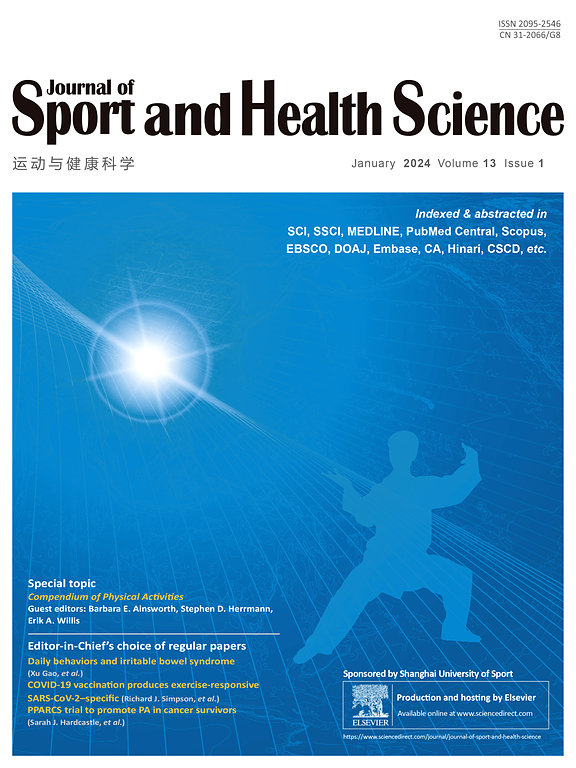限制热量和不同剂量的运动对 2 型糖尿病患者减脂的影响:DOSE-EX 随机临床试验的二次分析。
IF 9.7
1区 医学
Q1 HOSPITALITY, LEISURE, SPORT & TOURISM
引用次数: 0
摘要
背景:对于 2 型糖尿病患者来说,减脂主要体现在限制热量摄入方面。关于在限制热量摄入的过程中运动是否能促进脂肪减少,相关文献的研究结果并不一致。本分析旨在评估运动结合热量限制对确诊 2 型糖尿病患者脂肪量(FM)和脂肪百分比(FM%)的剂量反应效应。方法在对一项四臂随机试验进行的二次分析中,82 名 2 型糖尿病患者被随机分配到对照组(CON)(n = 21)、饮食控制组(DCON)(限制 25% 热量;n = 20)、饮食控制和每周锻炼 3 次组(MED)(n = 20)或饮食控制和每周锻炼 6 次组(HED)(n = 21),为期 16 周。主要分析指标为 FM% 分数的变化。DCON、MED和HED的无脂肪质量和内脏脂肪组织(VAT)体积(立方厘米)与CON相比分别下降了-3.5%(95%置信区间(95%CI):-5.6%至-1.4%)、-6.3%(95%CI:-8.4%至-4.1%)和-8.0%(95%CI:-10.2%至-5.8%),平均差异为-3.5%(95%置信区间(95%CI):-5.6%至-1.4%)、-6.3%(95%CI:-8.4%至-4.1%)和-8.0%(95%CI:-10.2%至-5.8%)。与DCON相比,MED和HED的FM%分别下降了-2.8%(95%CI:-4.9%至-0.7%)和-4.5%(95%CI:-6.6%至-2.4%)。HED和MED的去脂率差异为-1.8%(95%CI:-3.9%至0.4%)。与CON相比,DCON和MED减少了去脂质量,而HED保留了去脂质量(-0.2%(95%CI:-2.0%至1.7%))。与CON相比,DCON、MED和HED的VAT体积分别减少了-666.0立方厘米(95%CI:-912.8立方厘米至-385.1立方厘米)、-1264.0立方厘米(95%CI:-1679.6立方厘米至-655.9立方厘米)和-1786.4立方厘米(95%CI:-2264.6立方厘米至-1321.2立方厘米)。HED 比 DCON 更能减少 VAT 体积(-1120.4 cm3 (95%CI: -1746.6 cm3 to -639.4 cm3)),而其余的比较则没有发现任何差异。与单独限制热量相比,在限制热量的基础上增加运动能更好地降低FM%。本文章由计算机程序翻译,如有差异,请以英文原文为准。
Effects of caloric restriction with different doses of exercise on fat loss in people living with type 2 diabetes: A secondary analysis of the DOSE-EX randomized clinical trial.
BACKGROUND
Fat loss mainly conveys the benefits of caloric restriction for people living with type 2 diabetes. The literature is equivocal regarding whether exercise facilitates fat loss during caloric restriction. This analysis aimed to assess the dose-response effects of exercise in combination with a caloric restriction on fat mass (FM) and FM percentage (FM%) in persons with diagnosed type 2 diabetes.
METHODS
In this secondary analysis of a 4-armed randomized trial, 82 persons living with type 2 diabetes were randomly allocated to the control group (CON) (n = 21), diet control (DCON) (25% caloric restriction; n = 20), diet control and exercise 3 times per week (MED) (n = 20), or diet control and exercise 6 times per week (HED) (n = 21) for 16 weeks. The primary analysis was the change in FM% points. Secondary analyses included fat-free mass and visceral adipose tissue (VAT) volume (cm3).
RESULTS
FM% decreased compared to CON by a mean difference of -3.5% (95% confidence interval (95%CI): -5.6% to -1.4%), -6.3% (95%CI: -8.4% to -4.1%), and -8.0% (95%CI: -10.2% to -5.8%) for DCON, MED, and HED, respectively. Compared to DCON, MED and HED decreased FM% by -2.8% (95%CI: -4.9% to -0.7%) and -4.5% (95%CI: -6.6% to -2.4%), respectively. The difference in FM% between HED and MED was -1.8% (95%CI: -3.9% to 0.4%). DCON and MED decreased fat-free mass compared to CON, whereas HED preserved fat-free mass (-0.2% (95%CI: -2.0% to 1.7%)). Compared to CON, VAT volume decreased by -666.0 cm3 (95%CI: -912.8 cm3 to -385.1 cm3), -1264.0 (95%CI: -1679.6 cm3 to -655.9 cm3), and -1786.4 cm3 (95%CI: -2264.6 cm3 to -1321.2 cm3) more for DCON, MED, and HED, respectively. HED decreased VAT volume more than DCON (-1120.4 cm3 (95%CI: -1746.6 cm3 to -639.4 cm3)) while the remaining comparisons did not reveal any differences.
CONCLUSION
All interventions were superior in reducing FM% compared to standard care. Adding exercise to a caloric restriction was superior in reducing FM% compared to a caloric restriction alone.
求助全文
通过发布文献求助,成功后即可免费获取论文全文。
去求助
来源期刊

Journal of Sport and Health Science
SPORT SCIENCES-
CiteScore
18.30
自引率
1.70%
发文量
101
审稿时长
22 weeks
期刊介绍:
The Journal of Sport and Health Science (JSHS) is an international, multidisciplinary journal that aims to advance the fields of sport, exercise, physical activity, and health sciences. Published by Elsevier B.V. on behalf of Shanghai University of Sport, JSHS is dedicated to promoting original and impactful research, as well as topical reviews, editorials, opinions, and commentary papers.
With a focus on physical and mental health, injury and disease prevention, traditional Chinese exercise, and human performance, JSHS offers a platform for scholars and researchers to share their findings and contribute to the advancement of these fields. Our journal is peer-reviewed, ensuring that all published works meet the highest academic standards.
Supported by a carefully selected international editorial board, JSHS upholds impeccable integrity and provides an efficient publication platform. We invite submissions from scholars and researchers worldwide, and we are committed to disseminating insightful and influential research in the field of sport and health science.
 求助内容:
求助内容: 应助结果提醒方式:
应助结果提醒方式:


